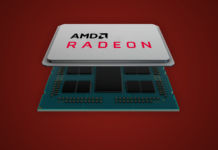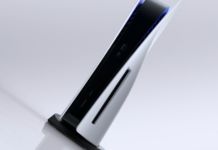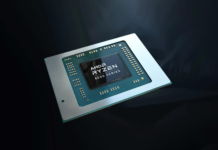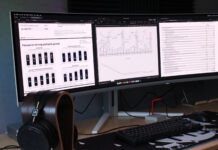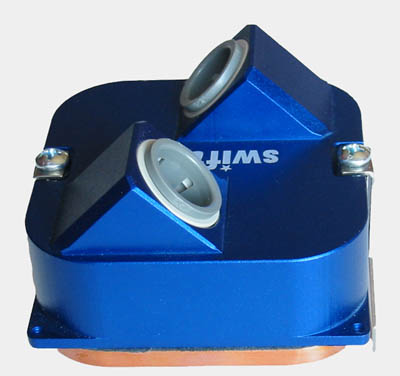A long time has passed since we last had a look at watercooling here at NordicHardware, but this ends today as we’ll have a closer look at some true heavy-weighters. We have the DangerDen Maze 1, 2 and 3, Swiftech MCW5000-A and two blocks from Aqua-Computer. Six blocks built after three very different main designs. The fact that there are so many designs is very interesting, since every single one of them has its own pros and cons. DangerDen and Swiftech are since a long time well-established in the watercooling market, whilst Aqua-Computer is pretty unknown to most of us. It will be terribly interesting to see how well it performs against the giants.
A long time has
passed since we last had a look at watercooling here at NordicHardware, but
this ends today as we’ll have a closer look at some true heavy-weighters.
We have the DangerDen Maze 1, 2 and 3, Swiftech MCW5000-A and two blocks from
Aqua-Computer. Six blocks built after three very different main designs. The
fact that there are so many designs is very interesting, since every single
one of them has its own pros and cons. DangerDen and Swiftech are since a
long time well-established in the watercooling market, whilst Aqua-Computer
is pretty unknown to most of us. It will be terribly interesting to see how
well it performs against the giants.
For starters, we’ll have a look at the Swiftech MCW5000-A.
|
Specifications:
Swiftech MCW5000-A™ |
|
|
Specifications
|
|
| Material: |
Copperbase,
aluminum casing |
| Inner construction: |
Chamber
with turbulence bottom |
| Nipple size: |
1/2"
(OD) , quick-fitted |
| Weight: |
352
grams |
| Installation Socket A: |
Screw
clips for socket |
| Installation Socket 478: |
Snap-on
clips for plastic cage |
| Installation Socket 603/604: |
Mounting
bracket for mainboad holes |
| Estimated price: |
€65
|
Swiftech is a
well-known brand when it comes to watercooling and it is a company known for
well-performing products of extraordinary high quality. The actual block is
made of both copper and aluminum. Whle this normally would create a galvanic
element and result in total oxidation of the aluminum, just to vanish totally
afterwards, Swiftech has solved this by anodizing the aluminium and thus made
it more resistant to corrosion. The anti-corrosion treatment is, according
to Swiftech, the best there is; "Type II, class II blue anodized anti-corrosion
treatment". It’s during this treatment the block gets its blue color.
|
|
|
The block consists
of two parts: the copper baseplate with its patented pattern used to achieve
maximal turbulence and contact with the water. Then there is the aluminum
case on top where the connections for the tubes are located. There are no
regular nipples on this block. Instead, there are "quick-connections"
that are mounted on the tubing, which subsequently are stuck into the holes.
These more or less demand that you use tubing of the right size, which we
will emphasize in the installation section later in this review. Enclosed
with the block comes a small tube of Artic Alumina, four plastic pipes used
to put inside connected tubes, a tool for disassembling and a hex key wrench.
| Installation |
|
|
|
The block is very
easy to install since it uses the standard mounting device. This means that
it doesn’t use the four holes that are found on virtually any mainboard these
days. This feature makes this block a suitable choice for those who don’t have
these holes. Instead of using regular nipples, Swiftech went with, as aforementioned,
a kind of quick-connections where you place a small plastic gadget inside the
tube which is pressed into the hole. This means that you will have to use tubing
of correct type; ordinary PVC hose worked well for me while silicon was too
thick. Personally, I think that it’s a minor drawback that you are restricted
to tubing of a certain outer diameter, as almost all tubing is sold based on
the inner diameter. If this is good or bad is however up to you.
Thanks to
Swiftech for contributing the waterblock.
|
Specifications:
DangerDen Maze1-C  |
|
|
Specifications
|
|
| Material: |
Copper
|
| Inner construction: |
Maze
construction |
| Nipple size: |
3/8"
(ID) |
| Weight: |
354
grams |
| Installation Socket A: |
Mounting
bracket for socket |
| Installation Socket 478: |
–
|
| Estimated price: |
?
|
DangerDen is
a real veteran when it comes to watercooling and has as such been with us
since the very beginning. In this test, we actually have all three generations
of waterblocks introduced by DangerDen and first on the stage is the Maze-1C.
This one is of the first generation, thus it’s true"old school".
The block consists of two segments made entirely from copper; the two halves
have been soldered together. It has the standard 3/8" nipples, made from
brass.
|
|
|
The surface of
the block is not entirely glossy, albeit with a certain shine. Some ordinary
brass polish probably works wonderfully regarding its appearance, if this
is of importance to you. The block is slightly smaller than newer DangerDen
blocks, which accommodates installation on any socket A mainboard, regardless
of the amount of capacitators placed close to the socket.
| Installation |
|
|
|
The installation process was easy enough to understand but it’s pretty tricky
to perform. There’s a springloaded piece of metal that is fastened to the socket
which subsequently presses the block against the CPU core. This block doesn’t
utilize the four holes and is therefore compatible with all socket A mainboards.
I was nervous when I attached the block because it felt like I was about to
crack the core in the process.
Thanks to Overclockers
for contributing this waterblock.
|
Specifications:
DangerDen Maze2  |
|
|
Specifications
|
|
| Material: |
Copper
|
| Inner construction: |
Maze
construction |
| Nipple size: |
3/8"
(OD) |
| Weight: |
389
grams |
| Installation Socket A: |
Four
metal poles for the holes |
| Installation Socket 478: |
–
|
| Estimated price: |
€45
|
This is the second
revision of the Maze block. The reason for including this one is not only
to get a solid base to stand on; there are a lot of second-hand blocks to
buy out there and this block is still relatively new. It’s is equipped with
DangerDen’s chrome nipples. Personally, I prefer brass nipples but that is
just me.
|
|
|
| Installation |
|
|
|
The block is mounted
by four springloaded screws that add pressure to the block. This is the most
common way to mount a waterblock and the most practical presupposing you have
the four holes on your motherboard. Installation went like a charm, just like
it’s suppose to do. The surface of the block is approved even if it isn’t exactly
as shiny as it could be. Some small cuts; oddly enough these cuts are right
by the core. This is not from a previous mount since the pictures were taken
perfore the block was ever mounted – it has to be pure coincidence that corrosion
appeared at that precise place.
Thanks to DangerDen for
contributing this waterblock.
|
Specifications:
DangerDen Maze3  |
|
|
Specifications
|
|
| Material: |
Kopparbas,
plexitopp |
| Inner construction: |
Labyrintkonstruktion
|
| Nipple size: |
3/8"
(ID) |
| Weight: |
346
g |
| Installation Socket A: |
Metallstavar
till de fyra hålen |
| Installation Socket 478: |
Metallstavar
till de fyra hålen |
| Estimated price: |
600kr
|
This is
DangerDen’s most famous waterblock and it goes by the name Maze3. As the
name suggests is the third design they released, not counting revisions on
older models. The nipples are 3/8" and appear to be chrome. They are
bolted and glued in the lexan-top. The block consists of two pieces, the lexan
top and the copper baseplate. There are an o-ring gasket to prevent leakage
and all in all it looks very posh. DangerDen have a little advertisment on the
block as well, if this is nice or not is again up to you.
|
|
|
The block has a
patterned bottom to give the water increased turbulence, without these the
block would be to lean to transfer the heat into the water efficiently. Aside
from the block this package includes the mounting device that consists of four
threaded metal rods, four highcut plastic rings, four lowcut plastic rings,
eight regular bolts and four wingnuts. This is a much better deal then the
four plastic rods DangerDen and other manufacturers insisted on including
earlier. It would have been nice to have gotten some instructions on how the
mounting device should be mounted, even if it isn’t that hard there are those
out there that might need the support.
| Installation |
|
|
|
I had no problems with this installation either, just fasten the block in the
four holes. The nipples are placed with a comfortable distance so there are no
hassles or obstacles when you want to tighten the block.
Thanks DangerDen
for contributing this waterblock.
|
Specifications:
Aquacomputer Cuplex  |
|
|
Specifications
|
|
| Material: |
Copper
+ plexi top |
| Inner construction: |
Maze
construction |
| Nipple size: |
3/8"
(ID) |
| Weight: |
272
grams |
| Installation Socket A: |
Four
metal poles for the holes |
| Installation Socket 478: |
Four
metal poles for the holes |
| Estimated price: |
€65
|
Aqua-Computer
has been around a while but it hasn’t made much fuss in the watercooling area.
Its blocks are tiny and relatively light. I think they are neat and all, but
those small channels make me wonder just how much the waterflow will be inhibited.
These blocks have a special kind of nipples; a form of half-locking covering
nipples that work just fine. The accessories include long screwes, a number
of plastic washers, four springs and four large bolts.
|
|
|
| Installation |
|
|
|
The surface is real
shiny against a source of light and reflects real nice. The reason for the strange
appearance of the reflection is because it is polished in curved lines instead
of straight ones. This makes the light bend in circular patterns. This installation
went without problems as well.
Thanks to Aquacomputer
for contributing this waterblock.
|
Specifications:
Aquacomputer Cuplex evo  |
|
|
Specifications
|
|
| Material: |
Copper
|
| Inner construction: |
3D
maze |
| Nipple size: |
3/8"
(ID) |
| Weight: |
428
grams |
| Installation Socket A: |
Four
metal poles for the holes |
| Installation Socket 478: |
Four
metal poles for the holes |
| Estimated price: |
€90
|
This is one of
Aquacomputers more expensive, heavier blocks. It has a very innovative design
with many water channels at various depths. Unfortunately, this block seems
to be very restrictive but can hopefully do it’s job with a lesser flow of
water. Bear in mind, though, that a restrictive block has negative impact
on the over-all throughput of a system. This means that a sensitive graphics
card block might give you a lot of trouble if you put a restrictive block
over your CPU, which will impede waterflow. The accessories are identical
with those you get with the cheaper variant of this block.
|
|
|
| Installation |
|
|
|
No problems with
the installation of the block. Aquacomputer’s nipples work very well with
PVC tubing. They have the same problem as Swiftech’s nipples however; you
need hose with a certain outer diameter instead of inner, which makes it harder
to find appropriate hose. The surface is not reflecting but very smooth. I
think it’s strange how the more expensive block has a surface inferior to
the cheaper model.
Thanks to Aquacomputer
for contributing this waterblock.
|
Test system
|
|
|
Hardware
|
|
| Processor: |
AMD
XP1700+ @ 2448MHz, 2.1V |
| Mainboard: |
Abit
NF7-S 2.0 |
| Waterblock: |
Swiftech |
| Waterpump: |
Eheim
1250 |
| Radiator: |
Black
Ice II |
|
Software
|
|
| Operativsystem: |
Windows XP Professional (Service Pack 1)
|
|
Test program:
|
MotherBoard
Monitor 5.3.4.0 |
Please note that
this part of the test will be replaced in a couple of months since I am currently
building a new rig for the sole use of testing waterblocks. Construction has
unfortunately taken too long and this review had to be published. You might
want to take these temperatures with a grain of salt but they should be pretty
accurate in general. A rough estimation of effect consumption in both cases
is that it develops approximately 50W in standard state and 135W overclocked.
|
Unclocked temperatures |
||||||||||||||||||||||||||||||||||||||||||||
|
||||||||||||||||||||||||||||||||||||||||||||
|
||||||||||||||||||||||||||||||||||||||||||||
|
Clocked temperatures |
||||||||||||||||||||||||||||||||||||||||||||
|
||||||||||||||||||||||||||||||||||||||||||||
|
||||||||||||||||||||||||||||||||||||||||||||
Swiftech is the
best waterblock, closely followed by Maze3. Following the Maze3 are the two
blocks from Aquacomputer. Note that the cheaper block actually out-performs
the more expensive block. Maze2 and Maze1 finish last but Maze2 stands up
quite well to modern waterblocks.
I’ve had a really
nice time here with all these waterblocks. Sadly, I didn’t have enough time
to finish the new testrigg. Performance values differed enough to draw a conclusion:
Swiftech brought home the gold with a pretty wide margin. The old trusty Maze3
finished second place with Aquacomputer sniffing in its heels. Remember that
these results are from my system; depending on waterflow and components, results
may vary a tad. I would recommend the following waterblocks:
Maze3, MCW5000-A and Aquacomputer Cuplex. They all have their pros and cons
but performance are quite similar between them. Surely, if you want the best,
Swiftech would be your choice, but many times aestethics play a role and many
of you out there are fond of the copper/plexi combination. Beyond that, Maze3
or Cuplex are well-designed waterblocks as well.
The earlier Maze blocks are nothing I would recommend anyone to buy, but this
test gives you a hint of whether it’s time to upgrade. If you’re the owner
of a Maze2, you will not experience any gigantic performance gain, however
the difference is present. If you have the slightly older Maze1, I would certainly
recommend an upgrade since that block is approximately 10 degrees celsius
hotter than the modern variant.
|
|
||||||||
|
|
||||||||
|
|
||||||||




